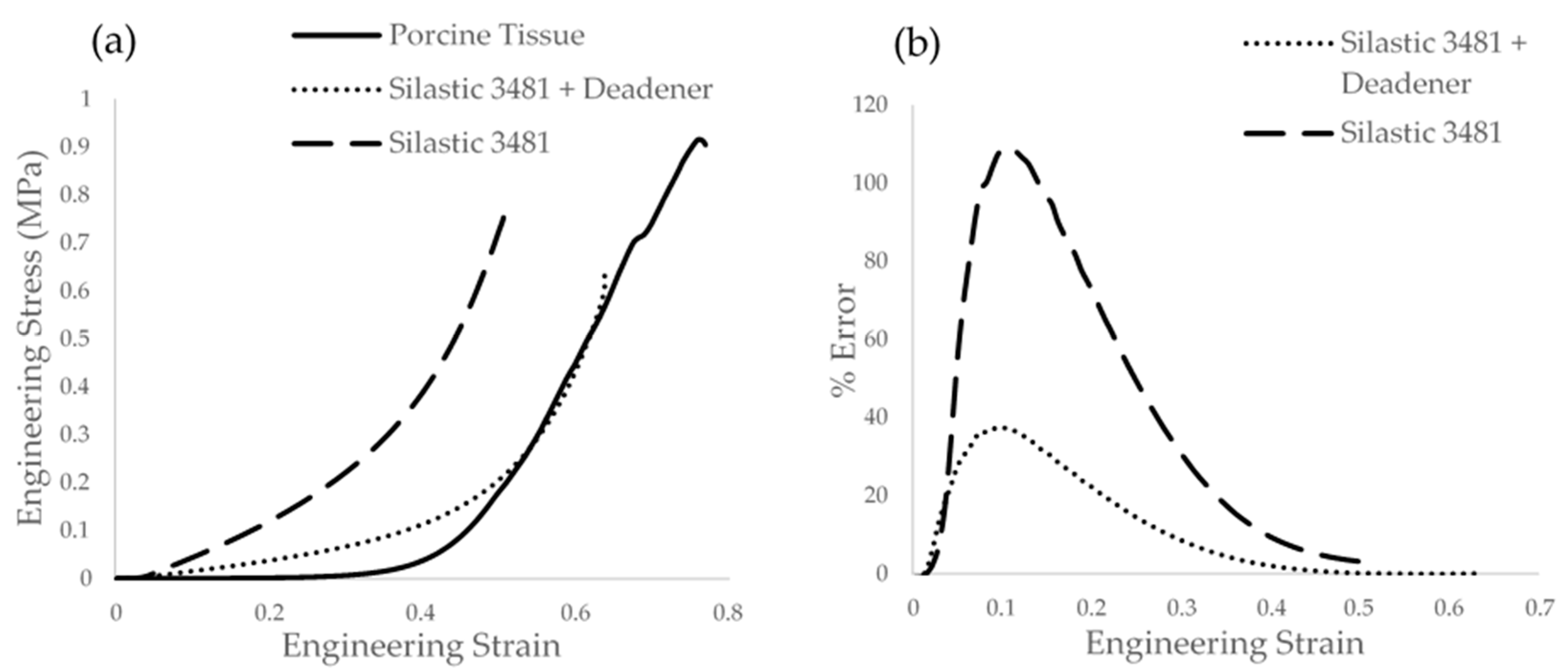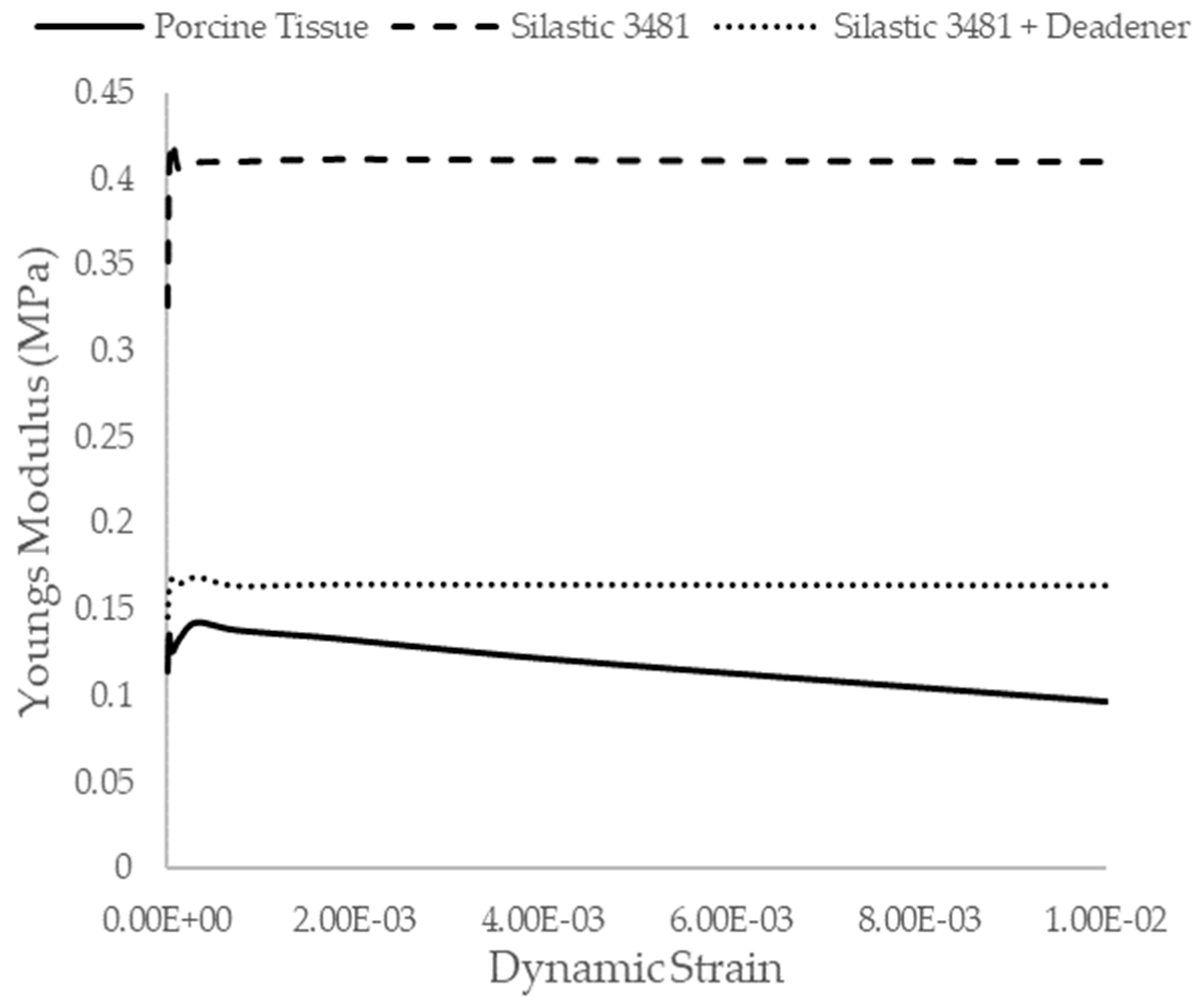Development of Silicone Elastomer for Use in the Assessment of Padded Clothing in Rugby Union †
Abstract
:1. Introduction
2. Materials and Methods
2.1. Material Preparation and Fabrication
2.2. Quasi-Static Compressive Material Characterisation
2.3. Dynamic Mechanical Analysis
3. Results
3.1. Quasi-Static Compressive Material Characterisation
3.2. Dynamic Mechanical Analysis
4. Discussion
5. Conclusions
Acknowledgments
Conflicts of Interest
References
- Fuller, C.W.; Brooks, J.H.; Cancea, R.J.; Hall, J.; Kemp, S.P. Contact events in Rugby Union and their propensity to cause injury. Br. J. Sports Med. 2007, 41, 862–867. [Google Scholar] [CrossRef] [PubMed]
- Seminati, E.; Cazzola, D.; Preatoni, E.; Trewartha, G. Specific tackling situations affect the biomechanical demands experienced by Rugby Union players. Sports Biomech. 2017, 16, 58–75. [Google Scholar] [CrossRef] [PubMed]
- World Rugby. Available online: https://www.world.rugby/handbook/regulations/reg-12?lang=en (accessed on 14 October 2019).
- Payne, T.; Mitchell, S.; Bibb, R.; Waters, M. Initial validation of a relaxed human soft tissue simulant for sports impact surrogates. Procedia Eng. 2014, 72, 533–538. [Google Scholar] [CrossRef]
- Hrysomallis, C. Surrogate thigh model for assessing impact force attenuation of protective pads. J. Sci. Med. Sport 2009, 12, 35–41. [Google Scholar] [CrossRef] [PubMed]
- Felsinger, N.; Black, K.; Breslin, T. Simulated Dissectible Tissue. U.S. Patent No. 14/875,067, 28 January 2016. [Google Scholar]
- Payne, T.; Mitchell, S.; Bibb, R. Design of human surrogates for the study of biomechanical injury: A review. Crit. Rev. Biomed. Eng. 2013, 41, 51–89. [Google Scholar] [CrossRef] [PubMed]
- Song, B.; Chen, W.; Ge, Y.; Weerasooriya, T. Dynamic and quasi-static compressive response of porcine muscle. J. Biomech. 2007, 40, 2999–3005. [Google Scholar] [CrossRef] [PubMed]
- Merkle, A.C.; Roberts, J.C.; Wing, I.D.; Voo, L.M.; Leese, C.B.; Conner, H.A. Human Surrogate Neck Model. U.S. Patent No. 9,011,158, 21 April 2015. [Google Scholar]
- Hendricks, S.; Karpul, D.; Nicolls, F.; Lambert, M. Velocity and acceleration before contact in the tackle during Rugby Union matches. J. Sports Sci. 2012, 30, 1215–1224. [Google Scholar] [CrossRef] [PubMed]
- Bensamoun, S.F.; Ringleb, S.I.; Littrell, L.; Chen, Q.; Brennan, M.; Ehman, R.L.; An, K.N. Determination of thigh muscle stiffness using magnetic resonance elastography. J. Magn. Reson. Imaging 2006, 23, 242–247. [Google Scholar] [CrossRef] [PubMed]
- Zheng, Y.P.; Mak, A.F.; Lue, B. Objective assessment of limb tissue elasticity: Development of a manual indentation procedure. J. Rehabil. Res. Dev. 1999, 36, 71–85. [Google Scholar] [PubMed]
- Iivarinen, J.T.; Korhonen, R.K.; Julkunen, P.; Jurvelin, J.S. Experimental and computational analysis of soft tissue stiffness in forearm using a manual indentation device. Med. Eng. Phys. 2011, 33, 1245–1253. [Google Scholar] [CrossRef] [PubMed]



Publisher’s Note: MDPI stays neutral with regard to jurisdictional claims in published maps and institutional affiliations. |
© 2020 by the authors. Licensee MDPI, Basel, Switzerland. This article is an open access article distributed under the terms and conditions of the Creative Commons Attribution (CC BY) license (https://creativecommons.org/licenses/by/4.0/).
Share and Cite
Hughes, A.; Driscoll, H.; Carré, M. Development of Silicone Elastomer for Use in the Assessment of Padded Clothing in Rugby Union. Proceedings 2020, 49, 77. https://doi.org/10.3390/proceedings2020049077
Hughes A, Driscoll H, Carré M. Development of Silicone Elastomer for Use in the Assessment of Padded Clothing in Rugby Union. Proceedings. 2020; 49(1):77. https://doi.org/10.3390/proceedings2020049077
Chicago/Turabian StyleHughes, Angus, Heather Driscoll, and Matt Carré. 2020. "Development of Silicone Elastomer for Use in the Assessment of Padded Clothing in Rugby Union" Proceedings 49, no. 1: 77. https://doi.org/10.3390/proceedings2020049077



